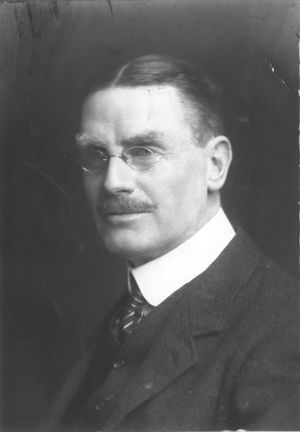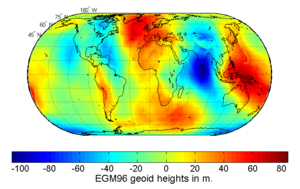Gerald Lenox-Conyngham facts for kids
Sir Gerald Ponsonby Lenox-Conyngham (born August 24, 1866 – died October 27, 1956) was an important Irish surveyor and expert in geodesy. Geodesy is the science of measuring and understanding Earth's shape, gravity, and rotation. He was the last leader of a huge mapping project called the Great Trigonometrical Survey in India. Later, he started teaching geodesy at the famous University of Cambridge in England.
Contents
Early Life and Education
Gerald Lenox-Conyngham was born in Springhill, Moneymore, County Londonderry, Ireland. His parents were Laura Calvert Arbuthnot and Sir William Fitzwilliam Lenox-Conyngham. He was one of eleven children.
When he was ten, his family moved to Edinburgh, Scotland. There, he attended Edinburgh Academy. At seventeen, he went to the Royal Military Academy at Woolwich. He was a brilliant student, graduating first in his class. He even won special awards like the "sword of honour" and the Pollock medal.
After Woolwich, he joined the Royal Engineers as a lieutenant. He spent two years training at the Royal School of Military Engineering in Chatham. After his training, he was sent to India.
A Career in Surveying India
In 1889, Gerald Lenox-Conyngham joined the surveying team in India. This team was part of the Great Trigonometrical Survey. He became an assistant to Sidney Gerald Burrard. That same year, Burrard began looking into why some measurements of longitude (east-west position) seemed a bit off. Their work together helped solve these puzzles. This was the start of a lifelong friendship between them.
In 1890, Lenox-Conyngham married Elsie Margaret Bradshaw. They had one daughter named Enid, who was born in India in 1892.
Mapping the World: Longitude and Gravity
In 1894, Lenox-Conyngham and Burrard worked together to precisely measure the longitude of Karachi. This important task involved traveling to Europe and the Middle East. Years later, using modern radio signals, their measurement was found to be incredibly accurate. It was off by only a tiny fraction of a second of arc.
In 1898, Lenox-Conyngham welcomed two British astronomers to India. They came to observe a total solar eclipse. One of these astronomers was Hugh Newall from Cambridge. Lenox-Conyngham and Newall became good friends. This friendship would later help Lenox-Conyngham's career at Cambridge.
Sidney Burrard had an interesting idea. He thought that strange readings in latitude measurements might be caused by a huge mass of rock under the Indo-Gangetic Plain. To test this, Lenox-Conyngham used special equipment. Between 1903 and 1908, he collected data about the Earth's gravitational force across India. His findings showed that the gravitational force was slightly lower in the area of the Plain. This was a big discovery, and modern maps of gravity still show this effect today.
In 1912, Lenox-Conyngham took over from Burrard as the superintendent (leader) of the Great Trigonometrical Survey. Two years later, he was promoted to colonel. For his important work, he was made a Fellow of the Royal Society in 1918. The next year, he was given the title of Knight Bachelor, meaning he became "Sir Gerald."
Teaching at Cambridge University
After returning from India in 1920, Sir Gerald had planned to live in Oxford. However, he was invited to join a committee at the University of Cambridge. This committee wanted to encourage the study of geodesy. He was very happy to be offered a teaching position there.
He moved to Cambridge and became a Fellow of Trinity College in 1921. Even though he hadn't gone to university himself, he was given an honorary Master of Arts degree. In 1922, a new teaching role was created just for him: the first "readership" in geodesy. This marked the start of his second career.
Developing Geodesy Studies
With little money from the university, Sir Gerald started teaching students by himself. He also taught new officers training for the Colonial Survey Service. These officers would spend a year studying geodesy before being sent to work abroad.
With help from Sir Horace Darwin, Sir Gerald designed new equipment to measure gravity. Darwin's company, the Cambridge Scientific Instrument Company, built this equipment. Sir Gerald also added seismology (the study of earthquakes) and geothermal science (the study of Earth's heat) to his lessons. He worked hard to get more money and equipment for his department.
He even went on an expedition to the Great Barrier Reef to study how Pacific islands float on the Earth's crust. He was also asked to visit Montserrat to investigate earthquakes there. Sir Gerald traveled worldwide, attending conferences and representing the British government at important science meetings. His department later became the Department of Geodesy and Geophysics. Many of his students became pioneering scientists, like the geophysicist Edward Bullard.
Sir Gerald retired in 1947. He passed away at the age of 90. His funeral was held at Trinity College Chapel. A special plaque with a Latin message honors him there. The message says that he "approved innovative ideas but also old-fashioned values. A kind, prudent, dutiful man."



